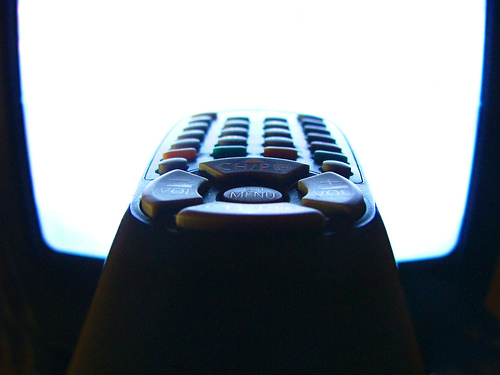Analog Broadcasting Ends
MULTIPLE U.S. CITIES:Today is officially the last day for TV signals to fly through the air in the form of sine waves. With the exception of 118 of the nation’s nearly 1,800 full-power TV stations, broadcasting will henceforth be transmitted in ones and zeros. The day marks the end of a 60-year era in the nation’s most ubiquitous electronic communications system. It followed Madonna’s adoption approval in Malawi, Carrie Prejean’s stripped beauty pageant title and Sarah Palin’s spat with David Letterman on the “Today” show.
Michael Copps got about 30 seconds to say the transition was the biggest to happen in TV history, exceeding the switch from black-and-white to color because legacy TV sets still displayed color signals, just in black-and-white. The Black Eyed Peas, by comparison, got nearly four minutes with “Boom Boom Pow,” a repetitive rap ditty that actually mentions the DTV transition, though in terms prohibited in broadcast by the FCC.
The “Today” reporter estimated number of unprepared households at 1 million. Nielsen’s number was 2.8 million as of June 7. Nielsen uses data from its People Meter samples. The National Association of Broadcasters came up with 2.2 million via a survey of 948 households that concluded June 3. Of those, the NAB said 450,000 either had applied for or received a $40 coupon from the federal government to buy a digital-to-analog converter box, leaving 1.75 totally unprepared.
The FCC has 4,000 people answering its hotline today, preparing for calls from people who may lose reception. Aside from those households that may lose reception for lack of proper equipment, there are also households that will suddenly fall out of the coverage area of TV stations they may have received in analog.
The commission recently estimated that 355 TV stations initially would lose reach to at least 2 percent of the viewing audiences in their given markets. The signal loss was derived from how the coverage of digital and analog signals compares. The commission said the loss would be brief in cases where stations are switching from temporary to permanent digital facilities.
The end of analog broadcasting generated multiple print stories. The Associated Press ran a fairly generic story with a dash of local color about 82-year-old Patricia Bruchalski of Brooklyn Park, Md., who’s converter box was hooked up by volunteers from a local community group. Poynter Online interviewed the president and general manager of KOAT-TV, the ABC affiliate in Albuquerque, N.M., the market with the highest percentage of unprepared households. Mary Lynn Roper said geography contributed to its status--the market is the nation’s second largest in terms of area. KOAT has around 50 translators, which will continue to broadcast in analog. No transition deadline has been set for low-power TV stations and translators, which essentially sling the signal of a full-power station into far-reaching corners of a market. The Wall Street Journal also ran a generic DTV transition story, with quotes from cable and DBS executive savvy to pick up subscribers in the switch. Comcast and Cox have both promoted same-day hook-ups for callers looking to subscribe.
While today marks the end-date of the DTV transition, its impact has been ongoing for years. Digital video compression was pioneered because of its mandate, and every component inherent in television broadcasting was reinvented because of it. New digital and hi-def TV sets were developed and sold. Around 112 million digital sets, according to the Consumer Electronics Association. Another 31 million converter boxes have been sold to adapt legacy analog TV sets, the CEA estimates.
Today marks a second milestone in communications—the launch of Long Term Evolution networks for fourth-generation mobile technologies. As broadcasters abandon the spectrum that was necessary to transmit both analog and digital signals, AT&T and Verizon will finally be able to use it. The two wireless carried scored the spectrum for a combined $15 billion in an auction held last year by the FCC. Both will deploy LTE networks with speeds far exceeding what’s currently available for wireless devices. Verizon will start in 20 to 30 markets in the first half of next year; AT&T will start testing LTE in 2010 with deployment planned for 2011.
Qualcomm, another carrier with a proprietary advanced wireless broadband technology, already announced its plan to expand into 39 new markets immediately following the transition. Qualcomm’s service is FLO TV, a mobile video offering based on its MediaFLO standard. The expansion will put FLO in 100 major markets by the end of this year.
Google and its partners in the Wireless Innovation Alliance are also on deck, poised to launch unlicensed devices in broadcast spectrum not specifically assigned to TV channels. Google continues to develop Android, the operating system created specifically for such devices. Jim Barthold of CED Magazine offers a perspective of the complications involved in deployed unlicensed devices in “White Space: Not Everyone Appreciates Free Air.”
“While everyone sees different potential for the spectrum, there is one area of across-the-board agreement: White space use and deployment isn’t going to happen overnight,” Barthold writes. He also quotes Miguel Myher of Accenture:
“Ultimately, down the line, five or 10 years out, it provides a great spectrum, but it still needs development and an ecosystem behind it.”
--Deborah D. McAdams
(Image by Daniel Horacio Agostini)

Get the TV Tech Newsletter
The professional video industry's #1 source for news, trends and product and tech information. Sign up below.
